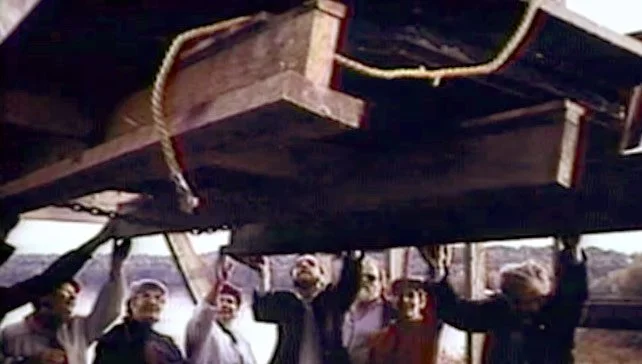History
Watch the video documentary of the Lighthouse, A Light on the Hudson:
PART 1: History (6 min., 4 sec.)
PART 2: Restoration (8 min., 11 sec.)
PART 3: Visiting (3 min., 31 sec.)
Timeline
1834
U.S. Congress appropriated $5,000 for a lighthouse at the mouth of the Esopus Creek. It was required to guide ships away from nearby shallows and into the Esopus Creek when Saugerties was a major port with daily commercial and passenger transportation.
1835
Construction began by Charles Hooster of Saugerties, who was awarded the low bid $2,988. The lighthouse was built atop a pier constructed of chestnut cribbing with stone fill. The lighthouse itself was a rectangular structure with a circular tower in the center. The light source was five whale oil lamps with parabolic reflectors.
1848
Lighthouse destroyed by fire. By 1850, the lighthouse was rebuilt on the old site. Four mineral oil lamps replaced the earlier whale oil lamps.
1854
Lantern refitted with sixth-order Fresnel lens and Argand lamp, visible at a distance of 10 nautical miles spanning an arc of visibility of 225 degrees.
1867
Congress appropriated $25,000 for construction of the present lighthouse.
1868
The reconstruction of the station was in progress. The pile foundation was finished and a part of the stone work of the protecting pier laid. It was expected that the pier would be completed and the house carried up and roofed before the close of the season, leaving the inside work to be completed in the spring.
1869
The present lighthouse became operational. It was built on a massive circular stone base sixty feet in diameter. The lantern and lens from the original lighthouse were relocated to the new building. The foundation for the original lighthouse remains as a small island adjacent to the exisiting lighthouse.
1873
The cast-iron lantern room was installed with an iron-plate walkway around it for cleaning the outside of the glass.
1888
The Saugerties harbor was enlarged to improve access by dredging the Esopus Creek and constructing a jetty.
1891
A post light was established July 22, 1891, on the outer end of the south dike, which was added to the duties of the resident keeper.
1899
The boathouse was moved to the stone pier, and a new fence with two gates was built around the pier.
1902
Material for the replacement of the footbridge from the stone pier to the adjacent island was landed. The stonework of the pier was pointed up.
1903
Contract was made for repairing the foundation piling here. The work consisted of driving a row of piling outside of the old damaged piling, securing the piles with an inside and outside waling strip, furnishing stone to fill in behind the piles and up to the pile tops, and furnishing tie bars to anchor the waling strip to the stone pier of the light-house. The work was begun on November 24 and on December 9, 1903 was completed.
1909
A fog bell established on the tower, struck by clockwork machinery (Gamewell 10,000-blow fog-bell striking machine).
1914
Oil house completed on north side for storage of kerosene and other inflammable supplies.
1940
Major repairs made to the Lighthouse.
circa 1947
Electricity, steam heat and telephone were added. Electric fog bell installed.
1954
The Coast Guard automated the light, making the light keepers obsolete. The building was closed up. Due to neglect, it fell into disrepair and decay in subsequent years.
1964
The Coast Guard announced plans to demolish the Lighthouse.
1972
As the condition of the Lighthouse continued to deteriorate, the beacon was removed from tower to a single pipe structure on adjacent island. Horn used instead of bell for fog signal.
1976
Saugerties Art Council formed a committee to attempt to save the Lighthouse.
1979
Local historian Ruth Reynolds Glunt and architect Elise Barry succeeded in placing the Lighthouse on the National Register of Historic Places. This stimulated local citizens to restore the building.
1985
Saugerties Lighthouse Conservancy formed with the purpose of acquiring the Lighthouse and restoring it to its former glory. The Coast Guard relinquished jurisdiction over the Lighthouse, and the property reverted to New York State.
1986
Assemblyman Maurice Hinchey and Senator Charles Cook co-sponsored a bill selling the Lighthouse and the adjacent wetlands to the Conservancy for the sum of $1.
1990
After extensive fundraising and restoration work the building was completely reconstructed. The Coast Guard installed a solar-powered beacon, and the lighthouse was officially re-commissioned as an aid to navigation on August 4, 1990.


